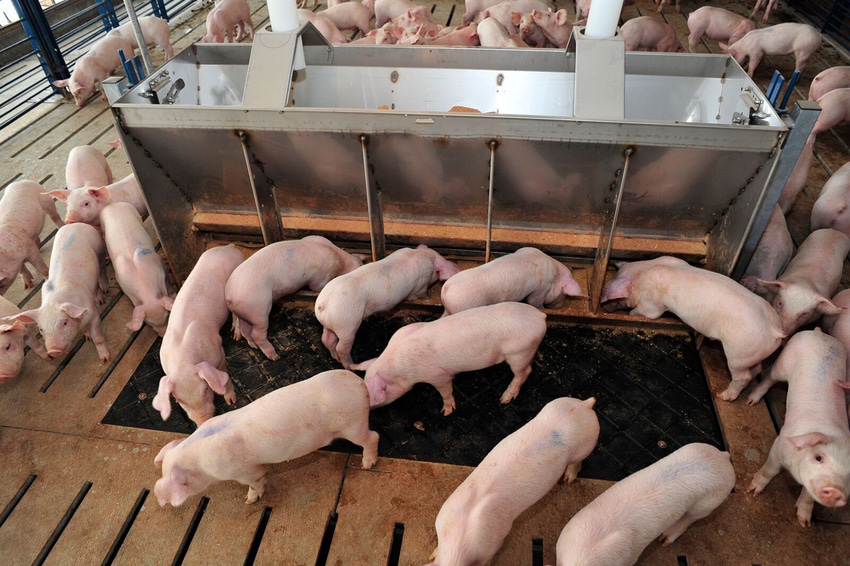Reduced dietary trace mineral supplementation may reduce diet cost, provide some diet formulation flexibility and decrease environmental impact.
March 17, 2022

Growing pigs require trace minerals for various biochemical functions including cofactors for enzymes and hormones, for example. The nutritional requirements for trace minerals can be met through dietary supplementation with different trace mineral sources into swine diets. Ignoring the innate levels of trace minerals found in other feedstuffs, common industry practices often include feeding trace minerals well above the defined NRC (2012) requirements (Flohr et al., 2016).
While levels of trace mineral supplementation above requirements provide a margin of safety in complete feeds, the practice may be potentially related to the belief that increased trace mineral supplementation leads to improved productivity. The late Professor Emeritus Don Mahan reported that "this method can negatively affect not only the animals, but also the consumer and environment."
In fact, research has shown that reducing or eliminating trace mineral supplementation during the finishing phase does not have an impact on overall performance (Patience and Gillis, 1995; Mavromichalis et al., 1999; Shelton et al., 2004; Gowanlock et al., 2013). Therefore, a study was conducted to evaluate the effects of feeding a commercial trace mineral premix at full and one-half rate on grow-finish pig performance.
The South Dakota State University on-site wean-to-finish research facility is uniquely designed with two rooms containing 20 large pens over four separate shallow manure pits within each room. These facility rooms are each stocked in rotation with a single wean group from the South Dakota State University Swine Education and Research Facility which batch farrows every 28 days. Each pen in the large pen rooms is designed to hold up to 15 pigs per pen from weaning to market.
In this trial, one group of pigs in each of the rooms were followed through the grow-finish phases of a nine-phase feeding program. Specifically, Group 1 was comprised of 195 pigs with an initial body weight of 77 pounds and pigs were housed with a stocking density of nine or 10 pigs/pen. Group 2 totaled 247 pigs with an initial body weight of 86 lbs with a stocking density of 12 or 13 pigs/pen.
The shallow manure pit location of each room dictated dietary treatment allocation within the room quadrants as either:
Standard corn-soybean meal diets with full trace mineral supplementation from the commercial premix.
Standard corn-soybean meal diets with 50% trace mineral supplementation from the commercial premix.
Each pen contained a single four-slot stainless steel feeder (SDI, LLC, Alexandria, SD) and two cup waterers providing pigs access to feed and water as desired. Pigs were weighed, feed disappearance was calculated from feed delivery and feed remaining reports, and shallow manure pit samples were collected every 21 days from the start of the trial to marketing.
Overall, there were no differences observed in average daily gain, average daily feed intake or feed efficiency between pigs fed diets with full trace mineral supplementation and pigs fed diets with 50% trace mineral supplementation.
Pigs were slaughtered at a commercial abattoir where carcass measurements were collected. Hot carcass weight, backfat thickness, loin depth and percent lean were not affected by the dietary trace mineral inclusion levels in this trial. This supports previous observations in that reducing or eliminating dietary trace mineral supplementation did not impact pig performance.
There were no differences in the concentrations of copper and zinc detected in the manure pit samples over the course of the study, but manganese and iron concentrations were greater when pigs were fed diets with full trace mineral supplementation compared to 50% supplementation.
In conclusion, these results indicate that supplementing dietary trace minerals at levels closer to NRC (2012) requirements in typical corn-soybean meal diets for grow-finish pigs does not have an impact on overall pig performance and carcass characteristics. However, reduced dietary trace mineral supplementation may reduce diet cost, provide some diet formulation flexibility and decrease the environmental impact associated with excess nutrient excretion.
References:
Flohr et al. (2016) A survey of current feeding regimens for vitamins and trace minerals in the U.S. swine industry. Journal of Swine Health Production 24:290-303.
Gowanlock et al. (2013) Evaluating the NRC levels of Cu, Fe, Mn, and Zn using organic and inorganic mineral sources for grower-finisher swine. Journal of Animal Science 91:5680-5686.
Mavromichalis et al. (1999) Effects of omitting vitamin and trace mineral premixes and (or) reducing inorganic phosphorus addition on growth performance, carcass characteristics, and muscle quality in finishing pigs. Journal of Animal Science 77:2700-2708.
Patience and Gillis (1995) Removal of vitamins and trace minerals from finishing diets: Impact on animal performance. In: Annual Research Report of the Prairie Swine Centre, Saskatoon, SK, Canada. p. 29-31.
Shelton et al. (2004) Effects of microbial phytase, low calcium and phosphorus, and removing dietary trace mineral premix on carcass traits, pork quality, plasma metabolites, and tissue mineral content in growing-finishing pigs. Journal of Animal Science 82:2630-2639.
Source: Marissa LaRosae and Ryan Samuel, who are solely responsible for the information provided, and wholly own the information. Informa Business Media and all its subsidiaries are not responsible for any of the content contained in this information asset.
You May Also Like



